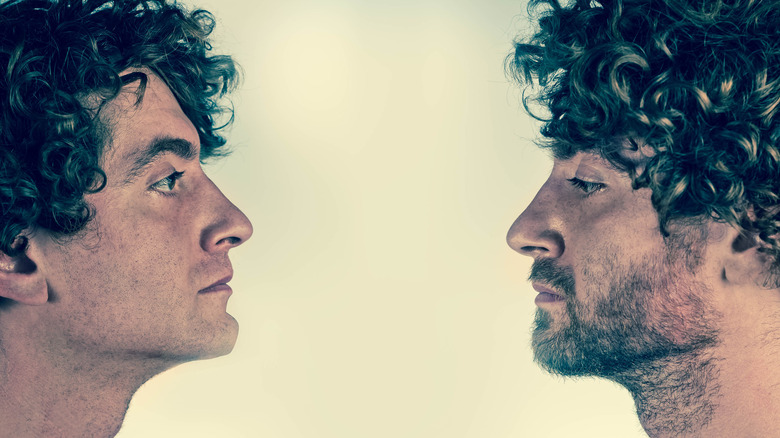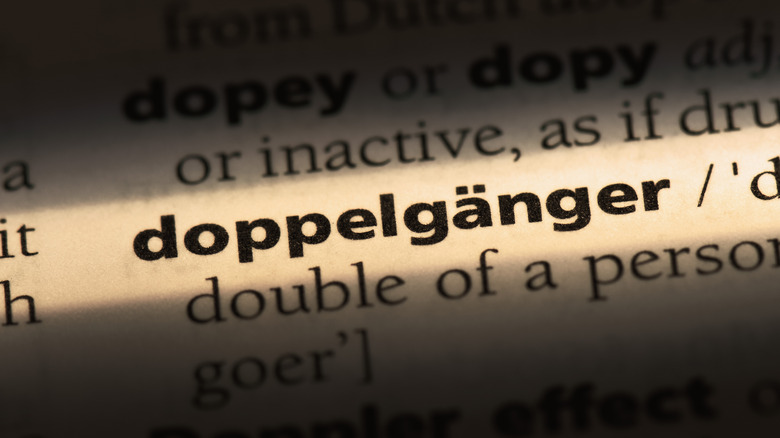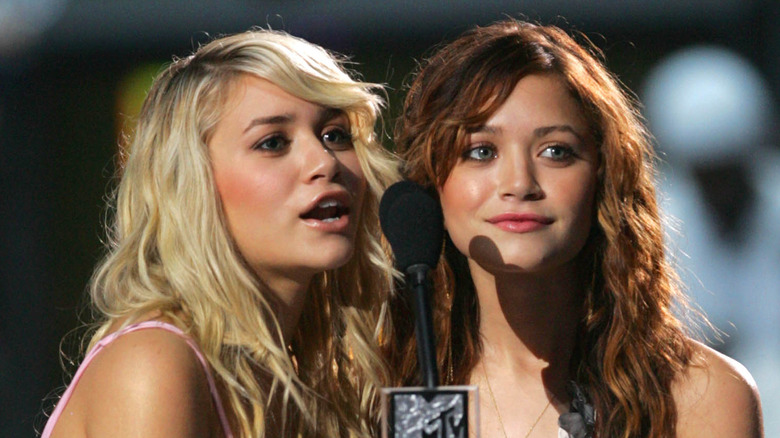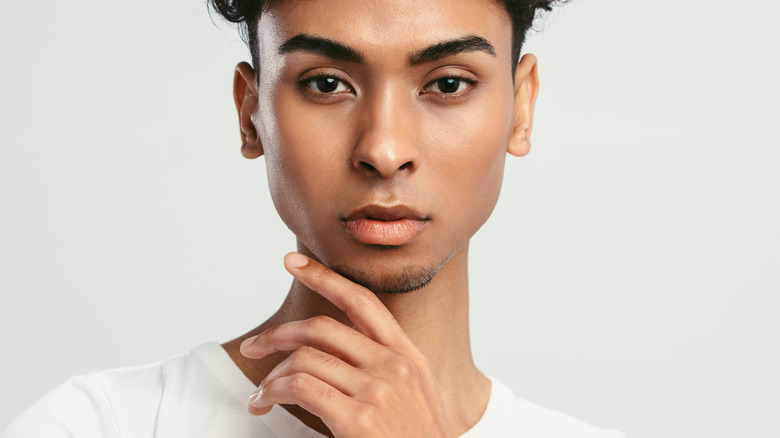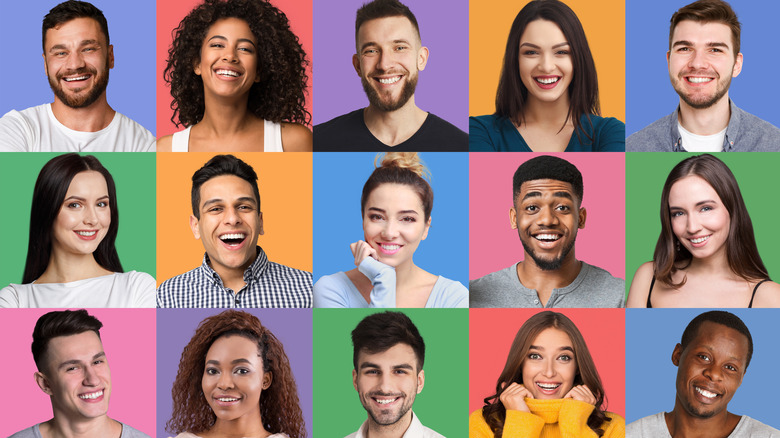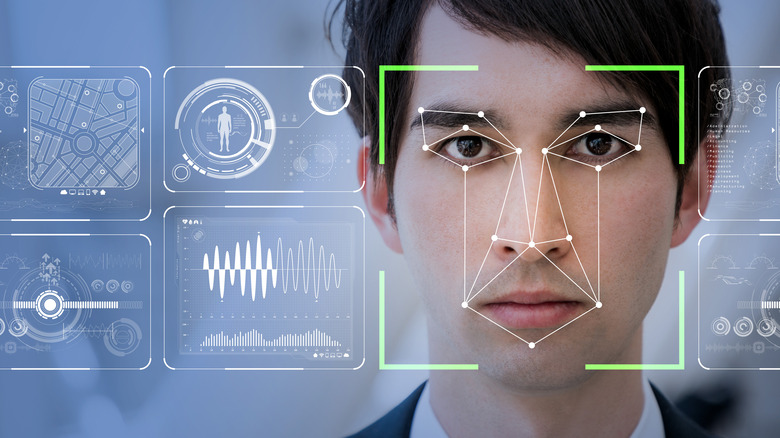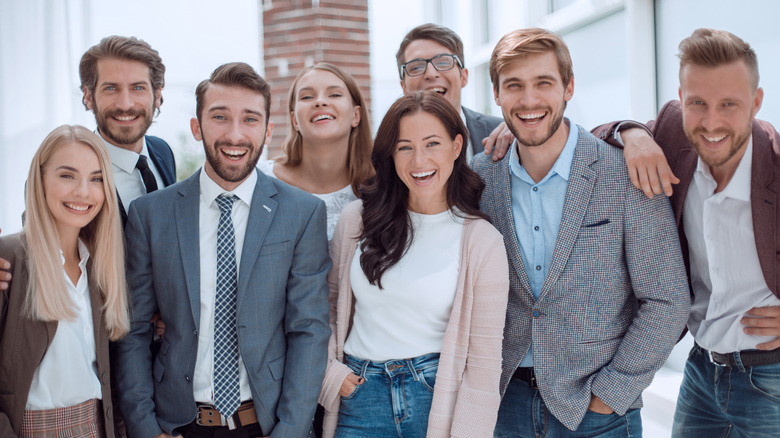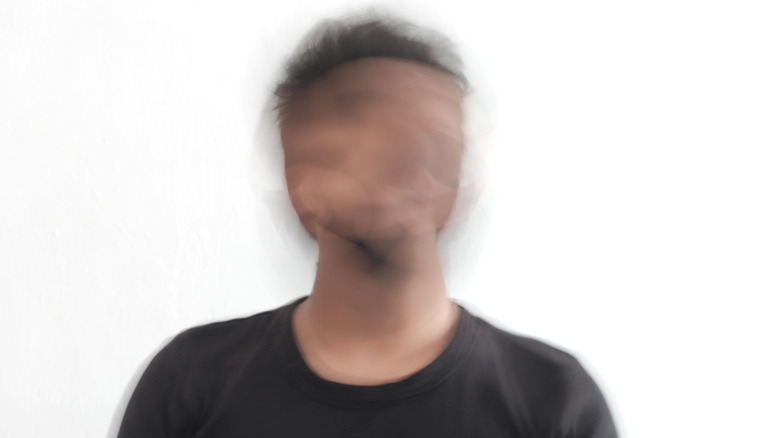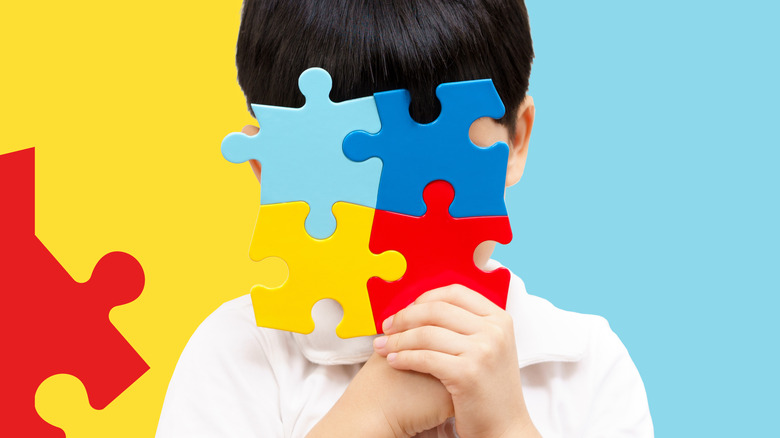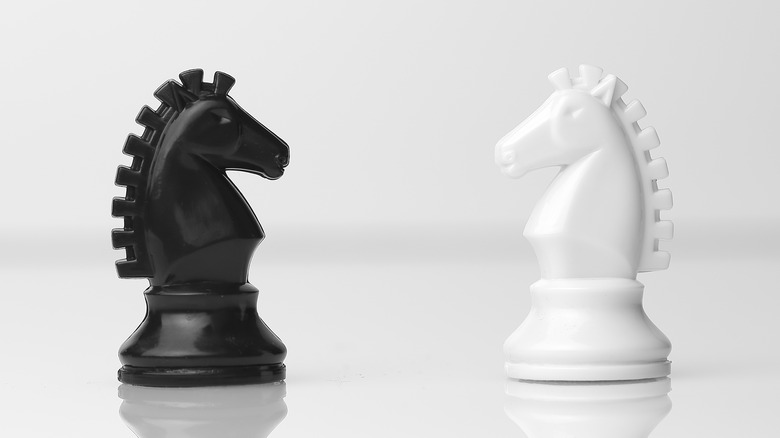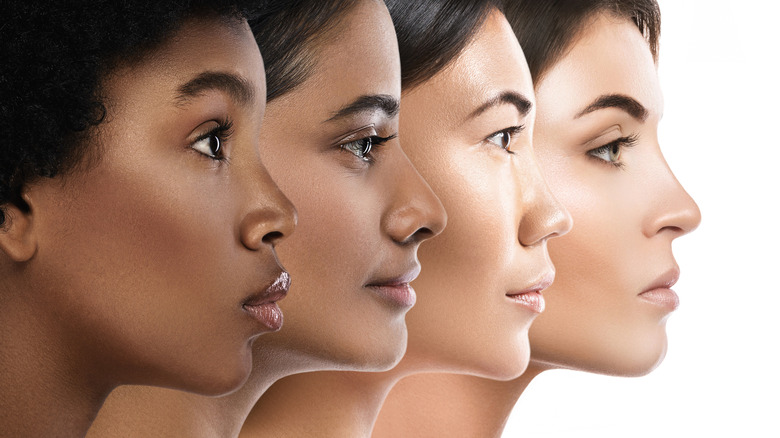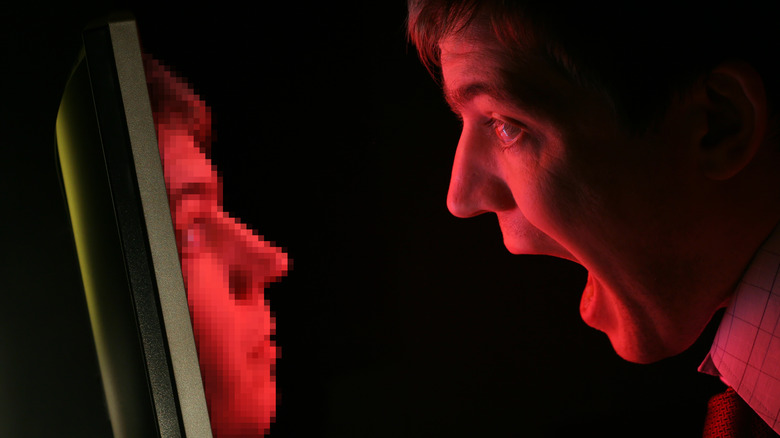You May Have An Identical Twin You're Not Related To. Here's How
Picture this: You're walking down the street, admiring your surroundings and minding your own business. All of a sudden, you hear an alarm getting louder by the second. A police car stops in front of you, and a cop steps out of the vehicle. "You're under arrest," they say, proceeding to name a bunch of offenses you have no recollection of committing. You deny the charges, but the officer tells you that an eyewitness saw you commit the crimes in broad daylight. As you step into the police car, exercising your right to remain silent, you wonder if you actually have a secret twin you never knew about.
Does that sound like something straight out of a movie? Tell that to Amanda Sylvester. According to a 2016 article from Deseret News, Sylvester, who was a teenager at the time, was arrested and jailed for her suspected participation in an armed robbery. A week later, she was freed when they caught the real perp: a young woman whose hair color, face, build, and even earrings were almost a perfect match for hers.
How likely is something like this? It turns out that there's a decent chance of you having an identical twin who you're not related to. Here's an in-depth look at the science of how people in different parts of the world end up having similar facial features, and why you might have a doppelganger.
The idea of the doppelganger
First used by German writer Jean Paul in his 1796 novel "Siebenkäs," "doppelganger" is a portmanteau of the German words Doppel (meaning "double") and Gänger (meaning "walker" or "goer"). Over the years, people have come to use the word to describe "an unrelated person who looks like" them (via the Genetic Literacy Project).
Considering the tremendous significance of a person's face in proving their identity, it's no wonder that many are interested in finding or even getting to know their own lookalikes. And given how the global population has hugely increased over the course of a hundred years (via LiveScience), the so-called "doppelganger effect" could have been positively or negatively influenced by the union of humans from different tribes and societies.
Still, matching doppelgangers is far from an exact science, and some of the people you think are doppelgangers may not even look that much alike at all. In an article published on How Stuff Works, neurobiologist Dr. Michael Sheehan explains that more often than not, it all boils down to familiarity. "You're a lot more likely to see a doppelganger of an acquaintance than your mom," he says. According to Sheehan, you'd understandably be good at distinguishing your mom from someone who looks like her, but put two unfamiliar people with a passing resemblance to each other side by side, and you'd be more likely to brand them as doppelgangers.
The science behind identical twins
While the idea of having an unrelated lookalike may sound like the stuff of science fiction, there's a decent chance you actually know identical twins in real life. According to the McGill Office for Science and Society, identical related twins (or monozygotic twins) happen when a fertilized egg forms a zygote that splits into two cell masses. There are also fraternal twins, which are siblings from separate eggs fertilized simultaneously. Fraternal twins aren't identical, as they're simply siblings that were born at the same time.
Humans don't have a monopoly on this whole monozygotic twin situation: armadillos, dogs, horses, and pigs are just a few examples of animals known to be capable of birthing identical twins. Interestingly, other animals may be capable of conceiving monozygotic twins as well; it's possible that because of the competition for nutrients in their mothers' wombs, their survival rate just drops significantly. LiveScience emphasizes that due to shared genes, family members are far more likely to look alike than complete strangers.
As anyone who knows twin siblings can attest, identical brothers and sisters look convincingly alike that they can easily fool the naked eye (via LiveScience). However, it's important to note that identical twins' genetic material aren't precisely the same, and that differences in both behavior and environment can help in telling them apart (via McGill).
How genes determine our facial features
According to the Genetic Literacy Project, gene expression — or the process in which certain genes are switched on and off as a child develops in the womb — determines the way our facial bones, muscles, and skin develop, thereby affecting our physical appearance. Genes are also the reason why some babies are born with cleft lips and palates, as well as other facial development disorders (via the Conversation).
Interestingly, researchers have only recently unlocked some of the secrets behind how our genes affect the way our faces look. In a 2020 paper published in Nature Genetics, scientists identified over 130 chromosomal regions affecting human facial shapes. They determined this by closely analyzing and comparing seven million genetic markers in over 8,000 subjects. All in all, the researchers estimate that there may actually be thousands of chromosomal regions that affect the way human faces develop. Furthermore, some of the effects may be so small (though no less meaningful) that it's entirely possible that scientists would never be able to pinpoint them.
The researchers reported that out of all the facial characteristics, genes affect noses the most. Diet and other lifestyle factors seem to have more impact on cheek size and shape than genetics. Not all genes influence the face in the same way, either; some affected larger areas of the face, while others only influenced small, specific portions.
Why we end up with different facial features
To understand why some people end up with the same result in life's facial features lottery despite not being related, it helps to know why not everyone looks alike. After all, human beings are from the same species — doesn't it make sense for people to look alike, in the same way cats, dogs, and mice seemingly share the same faces?
According to the Guardian, human DNA does follow a set of rules when it comes to forming faces; however, it's not a secret that scientists have managed to crack. Part of the reason is that the interaction between genes (epistasis) is a complicated process with "complex and unpredictable" effects (via the Conversation). Furthermore, the variations among human faces aren't overstated, but noticeable enough to make a difference. The distance between the eyes, thickness of the lips, or position of the nose on the face are just a few examples. In 2013, scientists found facial differences encoded in human's non-protein-coding (or "junk") DNA (via the Genetic Literacy Project).
While genes do affect human facial features, they're not the only factor responsible for why people have different faces. The 130 or so chromosomal regions believed to affect facial development can only do so much, after all. In fact, they only account for about 10% of facial shape variation; other biological and non-biological factors such as hormones, diet, age, and even sun exposure have roles to play in this as well.
How our brains recognize faces
To be able to spot a potential doppelganger, you must be able to distinguish, compare, and recognize faces first. It's also an extremely useful skill for humans, as sociable animals whose very survival depended on being able to quickly assess threats or recognize friendly faces.
For a long time, many neuroscientists backed two major but somewhat conflicting theories on how the brain processes this information. As Smithsonian Magazine explains, the exemplar coding theory sticks to the notion that the brain compares the facial features it sees to "extreme" examples, allowing it to distinguish one face from another. Meanwhile, the norm coding theory says that the brain actually compares the faces it sees to the "average" face.
Facial recognition systems separate an individual's facial characteristics (e.g. eye shape, nose height) and treat them as data points, which they uses to account for variations by performing searches in databases (via RecFaces).
And, according to the BBC, the brain's fusiform gyrus takes all the data a person sees regarding another individual's facial features and assesses them as a whole, following a sum-of-the-parts approach. This method is said to deliver much more accurate results to the brain than simply assessing eye size, nose shape, and other facial features individually. Interestingly, experiments with rhesus monkeys revealed that the neurons in the temporal lobe's "face patches" tend to fire up when it's analyzing a complete face, rather than just separate parts of it.
The importance of human individuality
Admit it: The thought that you might have a doppelganger is both fascinating and frightening. After all, no matter how cool the idea of having a non-related lookalike may sound, it opens the doors to potential cases of mistaken identity. This underscores just how important individuality is for humans — and why having unique facial features matters more to Homo sapiens than any other species.
In a 2014 paper published in Nature, researchers reported a greater degree of variation in humans' facial dimensions than in their hands. Furthermore, there are more genes connected to facial appearance than in any other aspect of the human body's development. Humans seem to have evolved specifically to be good at telling each other apart, as the capability to distinguish individuals requires not just observable differences among members of a group, but also the brainpower to process them. Compare that to how other animals tend to use either their ears or noses to identify each other even in pitch-black environments (via UC Berkeley).
This all circles back to how humans are a highly social species. As Dr. Michael Sheehan explained to LiveScience, distinct faces help people to identify allies and avoid threats as needed. Or, as UC Berkeley population geneticist Michael Nachman puts it: "The idea that social interaction may have facilitated or led to selection for us to be individually recognizable implies that human social structure has driven the evolution of how we look."
Being bad at recognizing faces
Due to humans' highly social nature, a person who isn't that good at recognizing faces is at a distinct disadvantage. It's not unheard of for people to see two similar faces and be unable to tell the difference between them (via ABC News), but interestingly, this seems to be more common in people who don't look at faces as wholes, but rather as individual parts. However, there are people who are just astronomically bad at recognizing faces, and it has nothing to do with having poor eyesight, being slow learners, or having dysfunctional memories.
According to FlipScience, prosopagnosia (also called face blindness) is a condition in which a person is unable to tell unknown faces apart or recognize their loved ones. In some extreme cases, prosopagnosics may even be unable to recognize themselves. The name of the condition comes from the Greek words for "face" and "lack of knowledge." Prosopagnosia may either be the result of a brain injury or a disorder from birth. Scientists say that it stems from the part of the brain in charge of facial perception and memory, the right fusiform gyrus.
Patients with autism have also been known to experience prosopagnosia. As the National Institute of Neurological Disorders and Stroke explains, prosopagnosia impairs communication and becomes an obstacle to social interaction. Some children are even born with it, meaning they've never even experienced how it feels to be able to tell faces apart.
Can faces reveal hints of genetic diseases?
Down syndrome is a developmental disorder that manifests in children with 47 chromosomes instead of 46 (the extra being a copy of chromosome 21). Interestingly, patients with this genetic condition share particular facial and cranial traits, regardless of their country of origin. According to How Stuff Works, this enables medical professionals to swiftly diagnose the condition. As it turns out, it's just one of thousands of genetic disorders that facial shape and other characteristics can point to.
As the Genetic Literacy Project explains, a chromosome 21 trisomy (or the occurrence of an additional chromosome) affects the development of recognizable physical traits. This is because the genes involved in this process also influence skull and organ development. Other examples of genetic disorders that distinct facial characteristics can reveal include Turner's syndrome, Angelman syndrome, and Fragile X.
In a 2020 article published in the Conversation, Seth M. Weinberg and John R. Shaffer shared how their examination of 8,000 DNA samples revealed "a high degree of overlap between the genes involved in facial and limb development." They believe that this is linked to why patients with certain genetic disorders tend to have both distinct facial characteristics and malformed hands. They also revealed that genes influencing facial shape development may have something to do with cancer development as well.
So why do some complete strangers look alike?
As numerous reports of doppelgangers over the years have proven, you don't have to have direct familial ties with a person to have similar-looking mugs. This also reveals something strange about human genetic diversity: that humans aren't actually that genetically diverse (via the Genetic Literacy Project). It's the same reason why certain genetic disorders can cause unrelated children to have similar facial traits, or why people from a certain country may have certain facial characteristics in common.
In an interview with Women's Health, American Society of Human Genetics executive vice president Joseph McInerney explained that two randomly selected people would still share about 99.5% of their genetic sequence. The remaining 0.5% is what accounts for the many differences across individual humans. Framing the discussion like this clearly shows why unrelated lookalikes can exist.
In fact, the word "unrelated" might not even be completely accurate. As Baylor College of Medicine geneticist Arthur Beaudet told Women's Health, doppelgangers might actually be distantly related, especially if they're from the same country. More research is needed to prove this theory, though.
Can your face say where you came from?
If your doppelganger does indeed exist, there's a pretty good chance that you'll find them living in the same country, city, or town as you, for the simple reason that people sharing the same ethnic background tend to have similar facial characteristics.
According to the Genetic Literacy Project, people have generated computerized facial composites of folks from specific ethnicities. This has revealed some shared characteristics within certain ethnic backgrounds that manifest in generated "average faces." LiveScience explains that people within the same ethnic group share a larger set of genes than people outside their group; this influences not just facial traits, but also skin color, hair color, and other physical characteristics.
Admittedly, it's neither easy nor completely fair to define ethnicity simply by genetic traits alone. After all, increasing global emigration means that formerly isolated racial groups have now started to interact and reproduce with one another, passing their genetic traits on to their offspring. However, it does stand to reason that people with shared genetic characteristics tend to live in the same groups, which means a higher chance of lookalikes emerging within them. This is especially the case if you're part of a massive ethnic group like the Han Chinese or the Hindustani, both from Asia. Oh, and don't forget that scientific evidence points to all of humanity emerging from Africa, anyway (via LiveScience).
What are the odds you have a doppelganger?
With about 7.8 billion people on the planet (via the Lancet), the chances of everyone having their own doppelganger may seem quite high. However, the BBC debunks this via the so-called coupon collector's problem: If one were to place 50 coupons in a jar, draw one, and put it back in, it would take approximately 225 tries to pull out all of the coupons at least once. In other words, the math it would take to figure out your doppelganger's odds of existing isn't as straightforward as it seems.
So, what are the chances that you'll spot someone who looks exactly like you as you're walking down the street? It depends on how high your standards are when it comes to your doppelganger. If you're particularly meticulous, the chances could be as slim as one in a trillion based on your face alone, or one in a quintillion if you factor your body shape into the equation (via How Stuff Works).
In 2015, forensic anthropologist Dr. Teghan Lucas and co-researcher Maciej Henneberg published a study on doppelgangers in the International Journal of Legal Medicine, in which they compared their subjects' similarities for eight facial characteristics and eight body measurements. Lucas sums it up nicely: "Two people may look very similar to the naked eye, but when you start measuring, they will not match each other."
You can use the internet to find your twin
Fortunately, you no longer have to wait for a random encounter just to find out if you have a doppelganger. There are various online resources that can help you find and identify your unrelated twin.
One of the most popular tools is the Twin Strangers Project. According to ABC 7, the project, which analyzes facial characteristics of user-submitted photos to process potential matches across the world, started out as a challenge among friends to test the theory that "there are 7 people in the world who look exactly like you." Another app, TwinsOrNot, takes the reverse approach, but with similar driving principles: After feeding it two profile photos, the app compares the images and assesses just how similar the faces in the photos are (via Windows).
Still, just because someone out there has a face that looks like yours, doesn't mean you can easily exchange places with them. Facial similarities notwithstanding, even the slightest difference in eye color, height, or nose shape will be obvious to anyone who knows and cares about you. Remaining blissfully ignorant about any possible doppelgangers isn't so bad — especially if it means no cop will mistakenly arrest you for a crime you didn't commit.
